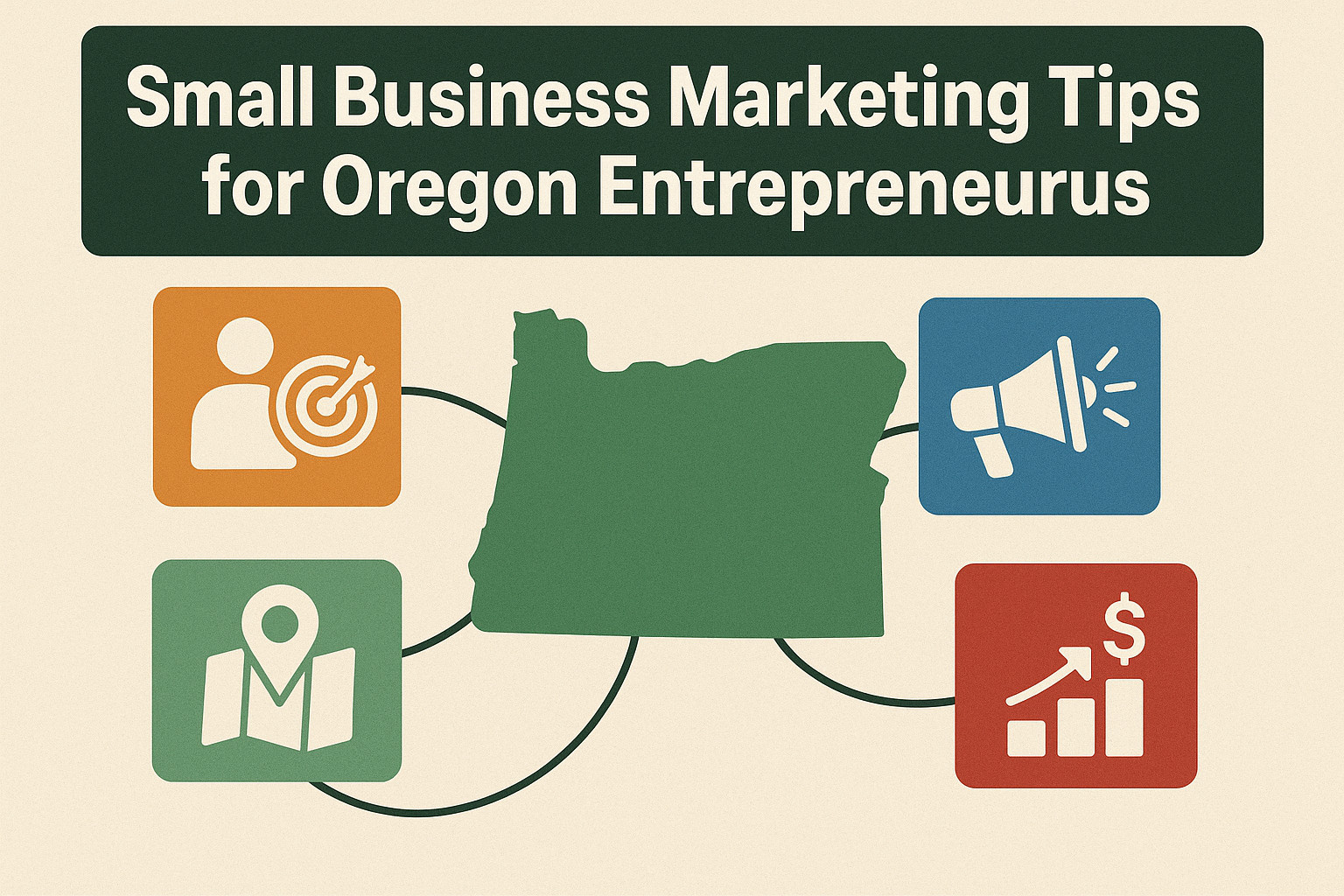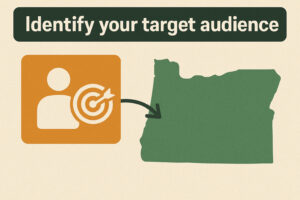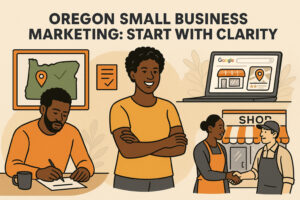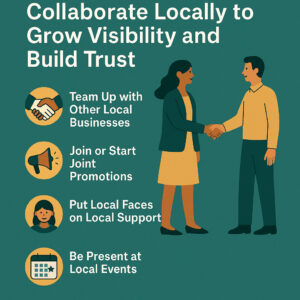Small business marketing tips: Before you promote anything, get clear on who you’re talking to and what makes you different. It sounds obvious, but a lot of businesses skip this, then wonder why their marketing isn’t landing. You can’t build real traction until you define two things:
- Your ideal customers (and what they care about)
- Your position in the market (and why people should choose you)
Know your local audience inside and out
Start with location. If you’re based in Oregon, your audience probably shares some regional traits—values, lifestyle preferences, seasonal habits, and community ties. Map those out. Even better, break your customer base into useful segments like:
- Location type: Urban vs. rural Oregon customers may respond to different messaging.
- Age and values: Are you targeting retirees who value local roots or younger customers drawn to sustainability?
- Purchase triggers: What’s frustrating them? What makes them act? Identify 2–3 common problems.
You’ll also want to factor in budget capacity, purchase frequency, and tech comfort. A younger crowd using mobile apps daily will expect different experiences than a less tech-native audience.
Sample Oregon Audience Segments (Quick Reference)
| Segment | Core Traits | Top Needs | Preferred Channels | Seasonal Peaks |
|---|---|---|---|---|
| Portland urban professionals | Mobile-first, value convenience, eco-minded | Fast service, transparent pricing | Instagram, Google Maps, Email | Spring events, summer festivals |
| Rural families (Willamette Valley) | Community-focused, price-sensitive | Reliability, local roots, deals | Facebook, Local radio, SMS | Back-to-school, harvest season |
| Coastal tourists & weekenders | Short trips, impulse buys | Clear hours, easy booking | Google Search, Maps, Reviews | Summer, holiday weekends |
| College towns (Eugene/Corvallis) | Trend-aware, budget-minded | Student discounts, social proof | TikTok/IG, Online reviews | Fall semester, graduation |
Find your edge and make it obvious
Once you know who you’re targeting, look at how you stack up. What can you do better than competitors? Maybe it’s faster turnaround. Maybe you support other local makers. Maybe your pricing fits tight rural budgets. Get specific here.Now use that edge to sharpen your unique value proposition—a short, plain-Spoken line that answers:
- Who you help
- What problem you solve
- Why you’re the right choice
Here’s a simple formula you can adapt:*We help [specific customers] in [location] solve [specific pain point] with [your core solution or advantage].*Keep refining that until it rings true. Then use it everywhere—your website, content, email intros, signage. The goal is to make your value so clear and familiar that people start remembering it before they even need you.Start with clarity, and everything else becomes easier.
Further reading: Branding for Small Businesses: Capture Oregon’s Market (2025)
Build a Marketing Plan That Can Flex With Your Business
Strong marketing starts with a smart plan. Not a 50-page document buried in a folder no one opens. A working plan that guides daily decisions, tracks real goals, and adapts when things shift.**Start with one question: What are you trying to achieve?**Be clear about the kind of growth you’re aiming for. Are you focused on getting more leads, selling faster, adding new services, or hitting monthly revenue targets? Set specific, trackable goals with a timeline. Think in short bursts—90-day targets are more manageable and keep you nimble.
Plan your budget before tactics
You don’t need a huge budget, but you do need a plan for how you’ll spend. Map out key buckets, such as:
- Website and content updates
- Local advertising (digital and offline)
- Email marketing tools
- Social media content and management
Factor in both time and money. If you’re handling tasks in-house, assign realistic hours so nothing gets dropped (or rushed).
Simple Budget Allocation Guide (Starter Template)
| Category | Suggested % of Monthly Budget | Typical Tools/Notes |
|---|---|---|
| Website & SEO | 25–35% | Hosting, CMS, local SEO tools, technical fixes |
| Content (blogs/video) | 15–20% | Writing, visuals, light production |
| Paid Ads (geo-targeted) | 20–30% | Google Ads/Meta, small A/B tests |
| Social Media | 10–15% | Scheduling tools, light boosting |
| Email & CRM | 5–10% | ESP fees, list growth offers |
| Community/Events | 5–10% | Booth fees, print, swag |
| Measurement | 3–5% | Dashboards, reporting time |
Turn strategy into actual actions
Now build an actionable plan that connects your goals to specific activities. A simple calendar works just fine. Lay out:
- What you’ll do (e.g. weekly blog, bi-weekly email, paid ad test)
- Who’s responsible (you, a contractor, an employee)
- By when (set review points, not just due dates)
Don’t try to do everything. Choose a small set of tactics that connect directly to your audience and your strengths. Then build consistency.
Check in, measure, and adjust
Every plan starts with guesses. That’s fine, as long as you check in often. Plan quick reviews every month or quarter to ask:
- What worked or showed signs of traction?
- What didn’t move the needle?
- Where did we spend too much effort with weak payoff?
Use simple tracking tools to collect enough data to make calls. Many businesses wait too long to adjust. You don’t need to overhaul every 30 days, but you do need to stay honest about what’s actually driving results.Your marketing plan isn’t a blueprint. It’s a living tool. Keep it simple, visible, and flexible.
Strengthen Your Online Presence Where It Counts
Your website is often the first impression customers get. If it’s slow, clunky, or confusing on a phone, they’ll bounce fast. That’s true whether they’re in Portland or a small town outside Bend. Oregon customers expect clean design, clear info, and easy navigation—especially on mobile.**Start with a mobile-first mindset.**Build or update your website so it works smoothly on phones and tablets. Test it yourself. Make sure buttons are big enough, text is readable without zooming, and menus don’t turn into a maze. Speed matters too. Use a basic tool to check your page loading time and clean up anything that drags it down.
Use your website to actually tell your story
Don’t just list products or services. Explain what makes you different. Make your homepage reflect your unique value (the one you defined earlier). Use photos that show your people, your place, and your work. Speak directly to your ideal customer. Keep the tone human, not corporate.Clear pages to include:
- About (who you are and what you stand for)
- Services or Products (detailed, scannable, honest)
- Contact (with a form, phone, and location info)
- FAQ (to handle repeat questions and save time)
Let SEO and content marketing bring traffic to you
You don’t need to compete with big national sites. Focus local.Use keywords that make sense for your area and your offerings. Think phrases like “[service] in Eugene” or “[product] near Salem.” Add these to your page titles, headlines, and page content—but keep it readable. Then back it up with helpful content. Write short blog posts that answer real local questions or give tips related to your business.Post consistently and use an internal link structure to connect related pages. Google notices when your content helps people stay longer and click deeper.
Related guides: Oregon Content Marketing Strategies for 2025 • 10 Local SEO Tips for Small Businesses in Portland Metro
Claim and maintain your local listings
Start with Google Business Profile. Fill out every section, upload updated photos, and pick categories that match how customers search. Keep your business hours and contact info current. Ask happy customers to leave reviews and respond when they do.Then work through the big directories. Check for your listing on platforms like Apple Maps, Bing, Yelp, and any relevant local directories. Make sure your name, address, and phone number (NAP) are an exact match everywhere. Google treats consistency like a trust signal.Your website and local listings don’t just inform—they earn trust. When they’re clean, coordinated, and current, they make you easier to find and easier to choose.
Use Social and Email Marketing to Actually Stay in Touch
Your online presence needs more than a good website. To stay top-of-mind and build real relationships, you need to show up where customers already hang out—and that means social media and their inbox.Start by picking the right social platformsDon’t try to be everywhere. Choose 1–2 platforms that match your audience’s habits and your team’s capacity. For Oregon small businesses, the most common picks are:
- Instagram (strong visuals, local lifestyle content, events)
- Facebook (wider demographic, great for community-focused updates)
- LinkedIn (if your business serves other businesses or professionals)
Use your customer personas to guide this. Where do your buyers spend time? What kind of content do they share or engage with? Answer that, and you’ll know where to start.
Social strategy help: Social Media Marketing Strategies for Oregon Businesses
Keep your content community-focused
Skip the hard sells. Focus instead on making your posts valuable, local, and consistent. Use a simple post mix like:
- Local spotlights (weather, farmers markets, small business ties)
- Behind-the-scenes (your day-to-day work, real people)
- Tips or info (short advice that’s helpful, not salesy)
- Customer appreciation (thank-yous, re-shares, shoutouts)
The goal is to build trust, not just drive clicks. Post regularly, even if it’s light. A few quality posts per week beat daily noise that burns out your audience.
Talk back—and mean it
Social isn’t a one-way street. When customers comment, like, or tag you, respond. Ask questions. Share their posts. Be human.Another smart move: use location tags and community hashtags where possible. It expands your reach inside your area and helps people see you as an active part of the local scene.
Use email to keep the relationship going
Email gives you direct access to your audience without a noisy algorithm in the way. But you’ll only get results if your emails feel personal and relevant.Segment your list by customer type or interest. This could be based on:
- Purchase behavior
- Location
- Service area
- Sign-up source (e.g. from a quote request vs. blog download)
Then send different emails to each group. For first-timers, share your story and a useful starter tip. For past buyers, offer a loyalty perk or product update. Keep it simple and clear. Use plain subject lines. Add one strong call-to-action per message—not five.**Email isn’t just for selling. It’s for building memory.**Show up consistently with content that helps, reminds, or connects. Then, when your reader needs your product or service, your name is already familiar—and trusted.
Email playbook: Boost Your ROI with Personalized Email Marketing Campaigns
Collaborate Locally to Grow Visibility and Build Trust
Oregon communities are tight-knit. People pay attention to who supports who. That means smart local partnerships aren’t just marketing—they’re reputation builders.Working with other Oregon businesses can expand your reach, boost your credibility, and deepen your roots.
Team up with other local businesses
Look around your block, your industry, or your clientele overlap. Think: “Who else serves my customer before, during, or after I do?” Then brainstorm simple ways to create shared value.
- Cross-promote in person or online (flyers, social shout-outs, reciprocal referrals)
- Bundle services or products into special offers
- Create a shared discount card or seasonal gift guide
Keep it practical. Look for win-wins that don’t add logistics headaches. If one of you has the storefront and the other has the audience, pair them. Swap shelf space. Co-host a live demo. Bring both audiences into the same conversation.
Join or start joint promotions
A solo promo can fall flat. But when two or more local brands align, it feels bigger and more exciting. Pick a theme—back-to-school, seasonal prep, community appreciation—and invite other businesses in.Coordinate your message. Use the same offer dates, hashtags, or printed banners. Promote each other through email, social, window signs, bag inserts—whatever channels you each already use. You don’t need a campaign manager. Just a shared goal and clear start/end dates.
Put local faces on local support
You don’t need national influencers. You need relatable ones. People in your own city who have a loyal following and actually engage.Start small. Look for:
- Local creators or bloggers with a niche audience
- Staff or customers who already advocate for your brand
- Community members with active, trusted voices (even on private group pages)
Build relationships first. Offer a product or service sample. Ask for feedback before any formal collaboration. If it grows naturally, negotiate a short content series like takeovers, reels, photos, or simple mentions.
Be present at local events
Show up where your customers already gather. Markets, charity runs, school events, holiday festivals—each one offers a real face-to-face chance to build recognition.Don’t just set up a table and hope for the best. Bring something visual or interactive. Offer something small to take away. And follow up online with a recap or thank you post tagging the event and other participants.The deeper your local ties, the easier it gets to grow by word of mouth. Build real visibility where people live, shop, and scroll—and they’ll remember you when it matters.
Marketing Tactics That Actually Drive Local Growth
You’ve got your strategy. Now it’s time to put it to work with boots-on-the-ground marketing that connects with your Oregon audience and supports long-term growth. These aren’t one-size-fits-all tactics—they’re flexible, local-first, and built for action.
Use paid ads with geo-targeting—not a blanket budget burn
Local paid ads can bring in highly qualified leads, but only if you narrow your focus. Geo-targeting lets you show ads specifically to people in your city, ZIP code, or radius around your store or service area.Start simple:
- Use location targeting in Google Ads, Facebook, or Instagram
- Write ad copy specific to Oregon regions or events
- Test small budgets and rotate based on performance
Make sure the landing page matches the promise in your ad—especially if you’re promoting a limited-time service, local perk, or city-specific offer. Otherwise, you’ll confuse or lose the click.
Launch a referral program that rewards both sides
Word of mouth works, but structure helps. Set up a referral program where both the referrer and the new customer get something meaningful. This could be a discount, store credit, or a free upgrade.Keep it easy to understand and repeat. Don’t over-complicate it. Simple rules, upfront rewards, clear instructions. Use a shareable link, card, or code. Remind people via email, at checkout, or in person.In small communities, people talk. Give them a reason to pull others in and feel good about it.
Offer loyalty perks customers actually care about
Whether you run a café or a service business, rewards for repeat business make a difference. Loyalty programs don’t need an app or punch card printer. What matters is consistency and real value.
- Choose a format: punch card, points per purchase, tiered benefits
- Align rewards with what customers really want (not what’s cheapest for you)
- Promote it clearly—on signage, receipts, follow-up emails
Even if it’s informal—like “Get your fifth coffee free”—show customers that coming back matters.
Try SMS marketing—but respect boundaries
Text marketing can work well for Oregon small businesses, especially for quick promos, appointment reminders, or event announcements. But it comes with rules, so move carefully.Follow these best practices:
- Only send texts to customers who’ve clearly opted in
- Keep messages short, timely, and useful
- Include a way to opt out and honor it fast
SMS is a privilege. Use it sparingly and with intent. Done right, it’s a direct line to your most engaged audience.
Let your storefront and site reflect where you are
Oregon has a strong regional identity. Tap into that. Your storefront and website should feel like they belong here—not copied from a big-box brand playbook.
- Showcase local materials, language, or cultural nods
- Rotate visuals based on local seasons or events
- Highlight your Oregon roots on your “About” page and signage
Small touches make a big impact. Think a familiar landscape photo on your homepage. Or greeting shoppers with a seasonal display that mirrors what’s happening outside your window. These details quietly say, “We’re for you.”Smart marketing isn’t louder—it’s sharper, more grounded, and invites the right people in.
Track What Matters—and Adjust on Purpose
You can’t improve what you don’t measure. But tracking everything just clogs up your dashboard. The goal is to monitor the signals that actually match your business goals, then use those to refine your marketing decisions month by month.**Start by choosing the right metrics.**Before opening an analytics tool, ask: What are we trying to learn or improve? Tie your questions to measurable actions, like:
- Are people finding us? Track search traffic and local listing views.
- Are they engaging? Check page visit length, scroll depth, shares, or email click-throughs.
- Are they buying or booking? Review form submissions, cart completions, or service signups.
Pick 3–5 key metrics tied to your current marketing focus. That’s enough to see what’s working without spiraling down a data rabbit hole.
KPI Tracking Dashboard Template (Fill Monthly)
| Goal | Metric | Target | Tool | Review Cadence | Action Trigger |
|---|---|---|---|---|---|
| Local discovery | Google Business Profile views | +20% in 90 days | GBP Insights | Monthly | If flat 2 months → add new photos & posts |
| Website engagement | Avg. time on key pages | >1:30 | Google Analytics | Monthly | If <1:00 → improve above-the-fold & CTAs |
| Lead generation | Form submissions | 10–20/mo | Site forms/CRM | Monthly | If down → test new offer/landing page |
| Email performance | Click-through rate | 3–5% | ESP (Mailchimp, etc.) | Campaign | If <2% → tighten list segments |
| Revenue | New customer count | +10% QoQ | POS/CRM | Quarterly | If flat → launch referral/loyalty push |
Use simple tools—but actually use them
You don’t need a full analytics team. Most small businesses can run a clean setup using basic tools:
- Website analytics (like Google Analytics or a user-friendly dashboard from your website platform)
- Email stats from your email marketing tool (opens, clicks, unsubscribes)
- Social media insights (look at reach, engagement, and comments more than likes)
- Google Business Profile activity (how many calls, directions, messages come through)
Block off time once per month to take a look. Don’t just screenshot the charts. Ask: What moved? Why? Take notes, even if it’s just a few bullet points. Trends live in consistency, not one-off spikes.
Tie your data back to decisions
Tracking only works if you use what it tells you. Here’s a practical approach:
- Review your metrics on a set schedule (monthly or quarterly)
- Note what actions you took during the period (campaigns, promotions, posts)
- Match the signals to the actions (what got traction, what didn’t?)
- Decide what to tweak (how will your next steps change?)
This applies whether you’re looking at ad performance, email responses, or homepage traffic. If that email campaign pulled better click-throughs, reuse that subject line format. If your local ads underperformed, rework your audience or offer before throwing more money at it.Measurement isn’t just math. It’s insight. When you stay curious and act on what you find, your marketing keeps getting sharper. And more profitable.




